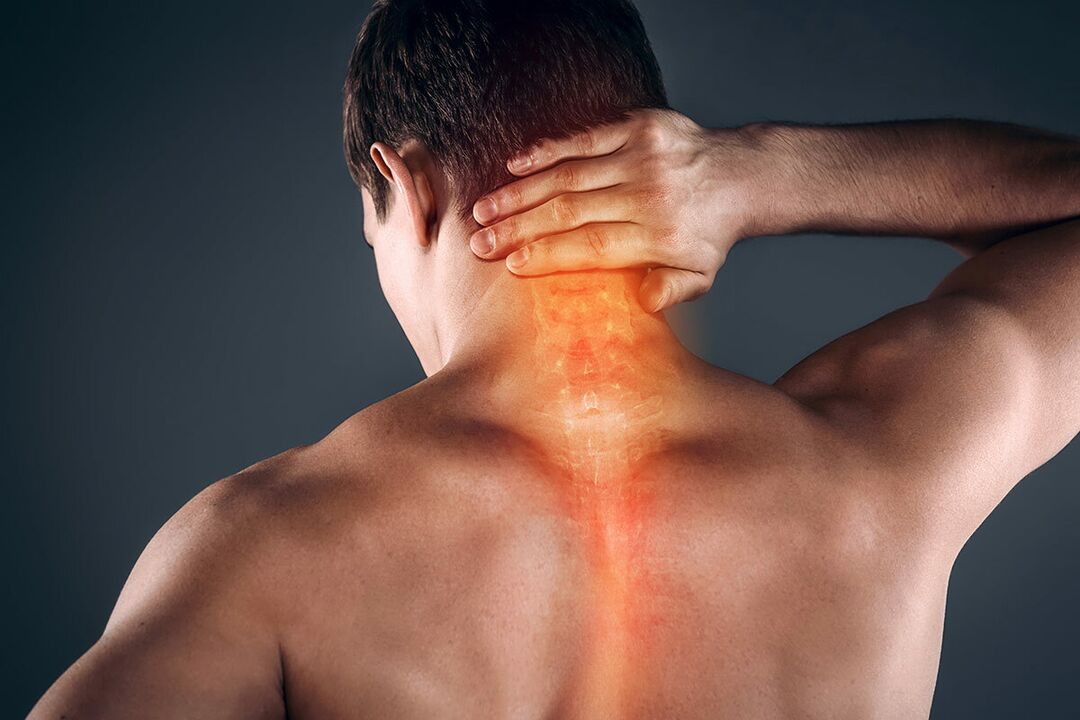
The neck is a mobile part of the spine, so it is often exposed to a disease such as osteonecrosis, in which dystrophy occurs. The cervical spine has seven discs, so it is responsible for tilting and turning the head. It is characterized by muscle weakness. If a person tries too hard on the neck, turns the head the wrong way, everything can end in a serious injury that leads to the development of osteonecrosis.
Developmental stages of osteonecrosis
- The initial stage, when the first violations appear in the vertebral discs.
- In the second stage, a significant decrease in the spaces between the vertebrae can be noticed, after which the nerves can be compressed, unpleasant sensations appear in the neck.
- In stage 3, the ring begins to collapse, forming a herniated mass between the vertebrae, the spine is severely deformed.
- Stage 4 is difficult, when moving very painful neck and back. A person cannot fully move. Sometimes it becomes easier, the pain lessens, but it is possible to form masses that develop, they affect the state of the vertebrae, as a result, a person becomes difficult to move. Bone tumors at this stage are very dangerous because they can lead to disability.
The main symptoms of osteonecrosis
When the spine is compressed, the integrity of the spinal cord is disrupted, and various symptoms appear. A pathological process is observed in the peripheral nervous system, bone and cartilage tissues can be destroyed.
Due to the disordered blood flow in the vertebral arteries, which gives rise to problems with the brain, it is deprived of oxygen, biologically valuable substances.
The following signs of osteonecrosis can be distinguished:
- Neck pain, which may radiate to the back of the head and shoulders. Severe headaches and migraines are frequent. Pain relievers don't always help with pain.
- Due to osteonecrosis, there may be belching, nausea, these symptoms indicate impaired blood circulation in the cerebral vessels.
- Body weight is reduced, the body is deficient in useful elements.
- Persistent vomiting can be excruciating, which is aggravated by turning the head, bending over, or walking. These symptoms are caused by impaired blood flow in the vertebral arteries and adequate oxygen not getting to the inner ear.
- A person suffers from hypoxia, this is due to the fact that the phrenic nerve is stimulated, it is responsible for the cervical solar plexus, with its help breathing is controlled. The patient has difficulty breathing, in difficult situations he or she is deprived of oxygen, has difficulty breathing, everything can end in a state of suffocation.
- At night, convulsions appear, accompanied by respiratory arrest, the patient snores a lot. Symptoms are aggravated when a person sleeps in an uncomfortable position in a dream, if the room has dry air, the patient seems to be suffocating. Therefore, in the morning, people do not get enough sleep, during the day they are often weak and unable to function. If a person has chronic shortness of breath, pathological processes in the brain tissues can occur, as a result, problems with attention and memory will appear in the future.
Tinnitus is a common symptom of osteonecrosis
With the help of the vertebral arteries, the blood supply to the vestibular apparatus takes place, when the function of the inner ear is disrupted, the ears can become severely tinnitus, as this arises problems. about hearing.
Often, a person cannot distinguish tinnitus from symptoms of other diseases in time. When the neck is affected, it causes tinnitus if the patient stays in one position for a long time. Other diseases are constant and intense tinnitus.
Sore throat due to bone necrosis
- Throat sore, as if something was in the way.
- Patients have difficulty breathing, difficulty swallowing, dry mucous membranes, itching in the throat. All this suggested that osteonecrosis affected the neurovascular system.
Often these symptoms can signal a tumor, a serious infection.
Vision problems and loss of consciousness due to osteonecrosis
The carotid arteries are involved in the circulation of the neck organs and rarely cause serious symptoms. Often, vision problems appear in old age, if a person has atherosclerosis, lowering blood pressure. The following symptoms appear:
- A veil covers my eyes.
- Visibility decreased.
- A large number of dots may flash before the eyes.
- One cannot focus on a particular subject.
- Visual leaps.
Exercise, glasses do not help in this situation, it is important to complete the full examination on time.
It will be very dangerous when the patient with osteonecrosis loses consciousness, which is caused by the inability of blood to enter the cerebral arteries. Often there are spasms in the arteries, they appear due to irritated nerve endings, deformed vertebral processes. You can bring the patient back to their senses by elevating their legs horizontally. So can improve brain circulation, later there are violations with speech, movement.
Arterial pressure reduction with osteonecrosis
Due to the fact that blood circulation in the canal is disturbed, interruption of arterial pressure can occur. With osteonecrosis, dizziness is often present, they occur because oxygen does not enter the inner ear.
Body temperature rarely rises, if abnormalities occur, this indicates an infectious disease, problems with the immune system - tumors. Sometimes the temperature rises in the affected area.
Therefore, if at least one of the listed symptoms appears, it is necessary to consult a doctor, diagnose the disease in time, undergo a course of treatment, may need massage, perform therapeutic exercises. Is it possible to prevent the disease in particular? from getting worse. Regularly monitor the condition of the spine - when walking, in a sitting position, lying down.
























